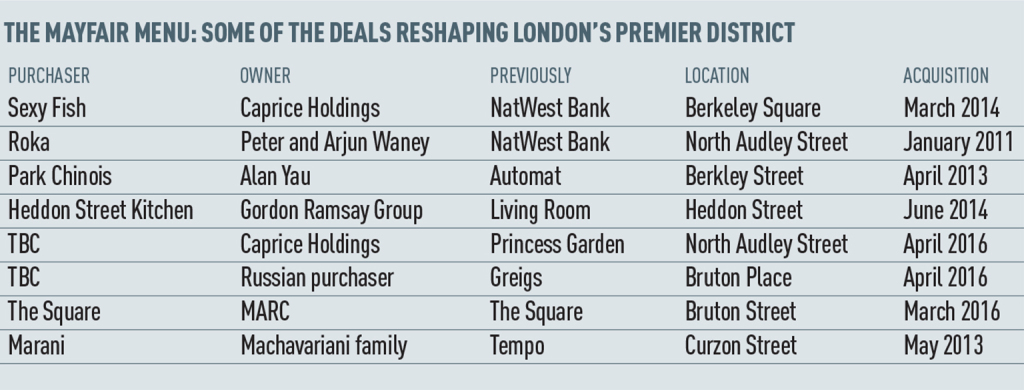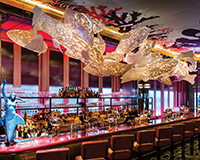Richard Caring’s Sexy Fish set a new benchmark for Mayfair rental rates, yet while the appetite for high-profile restaurant sites seems insatiable, soaring costs may not be to everyone’s taste

The rest of the world, it would appear, cannot get enough of central London. High-wealth individuals are lining up to buy swanky apartments at the best addresses, Bond Street is straining at its well-heeled seams to accommodate luxury retail brands and restaurateurs from all corners of the globe are scouring every potential location for a flagship outlet.
Yet it recently emerged that some of Mayfair’s best-known restaurants may be looking to cash in on soaring rents, which reached a new peak when Richard Caring’s Sexy Fish snapped up a former NatWest Bank building on Berkeley Square at a rate nudging towards £200 per sq ft. That transaction may have reflected a determination to secure the primest-of-prime locations, yet its impact will be to inch the London region’s asking rents up another notch.
A trio of prominent restaurants have sold up – The Square and Greig’s on Bruton Street, W1, and Princess Garden on North Audley Street, which sold its lease to Caprice Holdings in April and will re-open as another high-profile, 120-cover restaurant in the summer. Other restaurants that have left the area include Brasserie Chavot and Pescatori, which closed recently after more than 40 years on Dover Street.
Not only are rising rents forcing a reappraisal by some Mayfair stalwarts but the broadening of the capital’s food and drink spots is also offering up previously unattractive locations as rival sites to established upscale restaurants.
“You have to remember that for long-standing operators rents have gone from nearer £50 per sq ft 10 or 15 years ago to today’s rates,” says Nick Wier, a partner at Shelley Sandzer. “On top of that, there are business rates, the living wage and so on. So it is tough for operators and while there is always movement, some independents are being squeezed out.”
Despite this, Michael Webb, head of central London restaurants at JLL, points out that significant investment and the marketing potential of high-profile locations are maintaining the market and the steady flow of incomers. Caprice Holdings is reported to have spent more than £15m transforming the old NatWest Bank on Berkeley Square into Sexy Fish, while Alan Yau spent a similarly substantial sum on Park Chinois, the other high-profile recent arrival.
“Mayfair offers a very attractive location for those who ensure that their offer fits with the environment,” says Webb. “Mayfair is not only about fine dining but it does have that sense of refinement. It is less on the tourist trail and more of a business setting, with plenty of very wealthy local residents and financial-based businesses in the area.”
Benchmark deals
“Of course a deal like Sexy Fish has a wider impact on the whole area. It sets a benchmark. These flagships provide unique opportunities for some restaurant owners and that is why they are prepared to pay such high valuations,” says Duncan Lillie, managing director of professional services, at Shelley Shandzer. “As a result, there is a halo effect on rents but I think the high levels now being commanded have had an impact, not so much in departures but more in terms of those in-situ holding what they have but not looking to enlarge.”
He points to some restaurants giving back their upper floor for landlord conversion to offices as a strategy to offset costs, while he also foresees more turnover rents being requested by new entrants keen to see if results live up to potential. “I don’t see rents going a lot further,” he says. “But it is also worth remembering that even within Mayfair there are very big discrepancies between high-profile sites near Berkeley Square at perhaps £150 per sq ft and the bottom of St James’s at nearer £100 per sq ft.
It is a point picked up by Tracey Mills, executive director at Davis Coffer Lyons. “Historically, very few restaurants traded and the rents were suppressed, so in some ways what has happened is that Mayfair has come up to where it should have been,” she says. “And for the big players, Mayfair offers the big space and the signature locations. Yet there are much more affordable Mayfair locations.”
David Rawlinson, agency director at Restaurant Property and the man behind the deals for Sexy Fish, Roka and Princess Garden, says that more departures may follow. “These are challenging times, especially for some of the traditional fine dining restaurants that have higher labour and food costs and are also a little out of step with the modern preference for more casual environments and speedier service,” he says. “For the prime pitches only the best will be able to afford it, especially around Berkeley Square and Berkeley Street, where Novikov changed the whole location.”
Placemaking
Another factor is that landlords are beginning to curate areas where they have a dominant presence – Grosvenor around Mayfair, The Portman Estate in and around Marylebone, and Shaftesbury around Seven Dials – and manage them as overall locations, rather than deferring to the highest bidder.
“Grosvenor is really looking at placemaking and the tenant mix, which is not just about fine dining but also amenity and a broad mix of the more affordable,” says Mills, from Davis Coffer Lyons.
Rawlinson, however, remains concerned about some of the new players and their viability. “Some of the operators are working with the landlords to pay higher rents if it means they don’t have to pay a premium,” he says. “But should we be basing our expectations on those headline rents if they prove unsustainable and close after a year?”
Yet many deep pockets remain. Rawlinson adds: “What you should look at is not just the rents being paid but the scale. Restaurants used to be 30-40 covers with a total opening budget of around the £1m mark for fit-out but now it is in the tens of millions for 150-250 cover sites doing three sittings per day. Mayfair will always be attractive but it really is the survival of the fittest.”
Which way is London moving?
“Mayfair continues to be very popular with overseas operators, especially those from the US, who view London as a good platform for expansion into Europe,” says Michael Webb, head of central London restaurants at JLL. “The Mayfair location is part operation, part marketing, and they are prepared to take a little less margin, so I do not think we will see that change for the big international players.”
Although Webb does believe that some restaurateurs might migrate to emerging dining districts such as Fitzrovia, he feels this area is more likely to attract operators currently in Covent Garden or Soho. “Those being squeezed in Mayfair tend to be the traditional outlets, such as Italian restaurants, for example, which are unlikely to take their offer elsewhere,” he says.
Shelly Sandzer’s Duncan Lillie points to widening opportunities, such as well-established areas like Shoreditch and Hampton Wick, emerging areas such as Lewisham and Streatham and upcoming “Crossrail effect” locations, plus north Soho and Farringdon.
“That said,” he adds. “While these may be good locations for restaurants, they all have their own dining identity and are unlikely to attract many operators currently in Mayfair.”
Colleague Nick Wier says that for some operators the only option will be “sweating the assets harder”. He points out that more absentee overseas residential owners in nearby Knightsbridge is affecting that restaurant market and speculates that hotels may prove a safer bet for some operators looking to establish a presence in central London.
And Mills says that the affluence of Mayfair means it remains a unique catchment and retains its glamour. “The Mayfair chefs have tended to go out to individual locations in outer London rather than head east,” she says.












